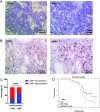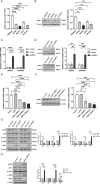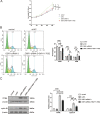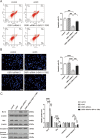OSR1 downregulation indicates an unfavorable prognosis and activates the NF-κB pathway in ovarian cancer
- PMID: 37642735
- PMCID: PMC10465422
- DOI: 10.1007/s12672-023-00778-0
OSR1 downregulation indicates an unfavorable prognosis and activates the NF-κB pathway in ovarian cancer
Abstract
Background: Odd-skipped related 1 (OSR1) has been reported as a tumor suppressor gene in various malignant tumors. The mechanism through which OSR1 regulates ovarian cancer (OC) progression remains unclear.
Materials and methods: Immunohistochemistry was utilized to evaluate OSR1 expression in patients with ovarian cancer. We investigated the association between clinicopathological parameters and OSR1 expression in OC patients and the influence of OSR1 expression on patient survival and prognosis. OC cells with OSR1 overexpression or knockdown were established and validated using Western blot and Quantitative reverse-transcription polymerase chain reaction (qRT-PCR). The influence of OSR1 on the NF-κB pathway was examined by analyzing the p-IκBα, IκBα, p65, and p-p65 protein expression. In vitro assays, such as cell cycle assay, Cell Counting Kit-8 (CCK-8), transwell invasion assay, wound healing migration assay, enzyme-linked immunoassay (ELISA), and Annexin V/PI flow cytometry apoptosis assay, were conducted to explore the effect of OSR1 knockdown or dual inhibition of OSR1 and the NF-κB pathway on OC malignant biological behavior.
Results: OSR1 expression was downregulated in OC tissues, with significant associations observed between its expression and The International Federation of Gynecology and Obstetrics (FIGO) stage and tissue differentiation. Low OSR1 expression in OC patients correlated with reduced overall survival (OS) rates and poor prognosis. In vitro, experiments confirmed a negative correlation between OSR1 expression and NF-κB pathway activity. OSR1 knockdown facilitated OC cell malignant biological behavior, while the NF-κB pathway inhibitor (Bay 11-0782) reversed the impacts of OSR1 knockdown on cell proliferation, migration, invasion, and apoptosis.
Conclusion: Our findings indicate that OSR1 is downregulated and associated with OC prognosis. OSR1 suppresses NF-κB pathway activity and inhibits OC progression by targeting the NF-κB pathway.
Keywords: Downregulation; NF-κB pathway; OSR1; Ovarian cancer; Unfavorable prognosis.
© 2023. Springer Science+Business Media, LLC.
Conflict of interest statement
The authors declare that they have no competing interest.
Figures





Similar articles
-
Odd-skipped related 1 plays a tumor suppressor role in ovarian cancer via promoting follistatin-like protein 1 transcription.Hum Cell. 2022 Nov;35(6):1824-1837. doi: 10.1007/s13577-022-00767-5. Epub 2022 Aug 14. Hum Cell. 2022. PMID: 35964260
-
Odd-skipped related transcription factor 1 (OSR1) suppresses tongue squamous cell carcinoma migration and invasion through inhibiting NF-κB pathway.Eur J Pharmacol. 2018 Nov 15;839:33-39. doi: 10.1016/j.ejphar.2018.09.020. Epub 2018 Sep 19. Eur J Pharmacol. 2018. PMID: 30244004
-
F-Box and Leucine-Rich Repeat Protein 20 (FBXL20), Negatively Regulated by microRNA (miR)-195-5p, Accelerates the Malignant Progression of Ovarian Cancer.Mol Biotechnol. 2021 Dec;63(12):1235-1243. doi: 10.1007/s12033-021-00375-y. Epub 2021 Aug 2. Mol Biotechnol. 2021. PMID: 34338995
-
CD44v6 may influence ovarian cancer cell invasion and migration by regulating the NF-κB pathway.Oncol Lett. 2019 Jul;18(1):298-306. doi: 10.3892/ol.2019.10306. Epub 2019 May 3. Oncol Lett. 2019. PMID: 31289500 Free PMC article.
-
Patchouli alcohol suppresses castration-resistant prostate cancer progression by inhibiting NF-κB signal pathways.Transl Androl Urol. 2022 Apr;11(4):528-542. doi: 10.21037/tau-22-220. Transl Androl Urol. 2022. PMID: 35558260 Free PMC article.
Cited by
-
The CoREST complex is a therapeutic vulnerability in malignant peripheral nerve sheath tumors.Sci Rep. 2025 Mar 24;15(1):10128. doi: 10.1038/s41598-025-94517-w. Sci Rep. 2025. PMID: 40128216 Free PMC article.
-
Identification and validation of DNA methylation-driven gene OSR1 as a novel tumor suppressor for the diagnosis and prognosis of breast cancer.Front Genet. 2025 Jul 7;16:1583620. doi: 10.3389/fgene.2025.1583620. eCollection 2025. Front Genet. 2025. PMID: 40692711 Free PMC article.
References
-
- Allemani C, Weir HK, Carreira H, Harewood R, Spika D, Wang XS, et al. Global surveillance of cancer survival 1995–2009: analysis of individual data for 25,676,887 patients from 279 population-based registries in 67 countries (CONCORD-2) Lancet. 2015;385(9972):977–1010. doi: 10.1016/s0140-6736(14)62038-9. - DOI - PMC - PubMed
-
- Katoh M. Molecular cloning and characterization of OSR1 on human chromosome 2p24. Int J Mol Med. 2002;10(2):221–225. - PubMed
LinkOut - more resources
Full Text Sources
Research Materials
Miscellaneous
